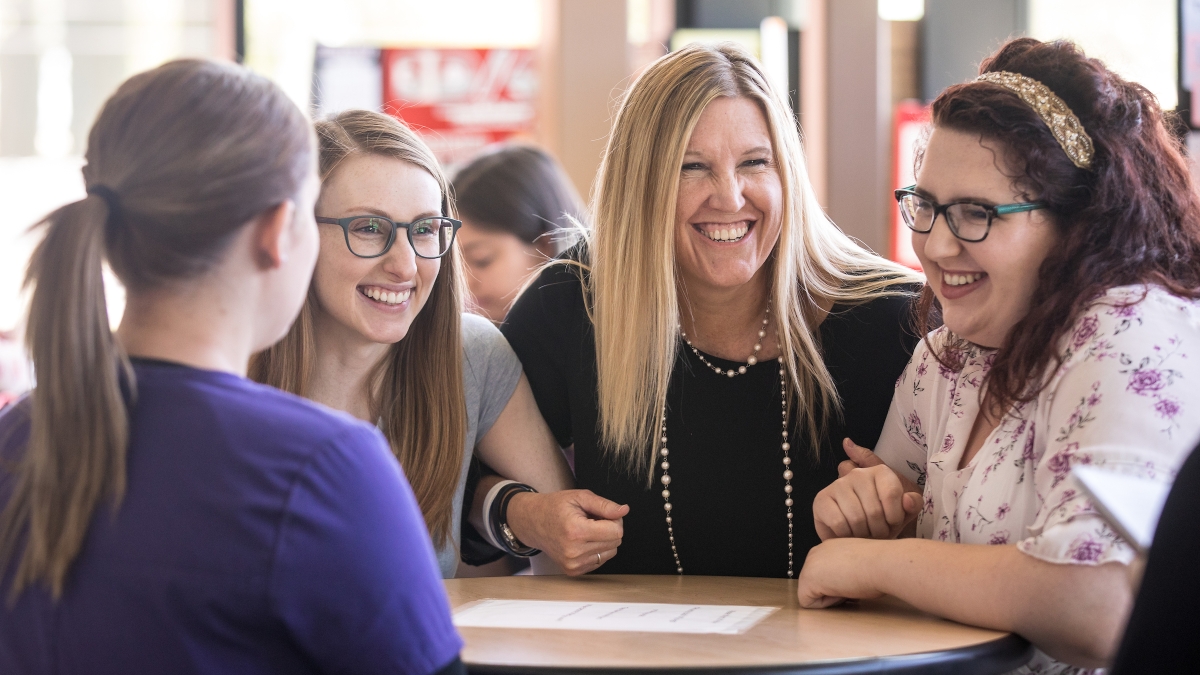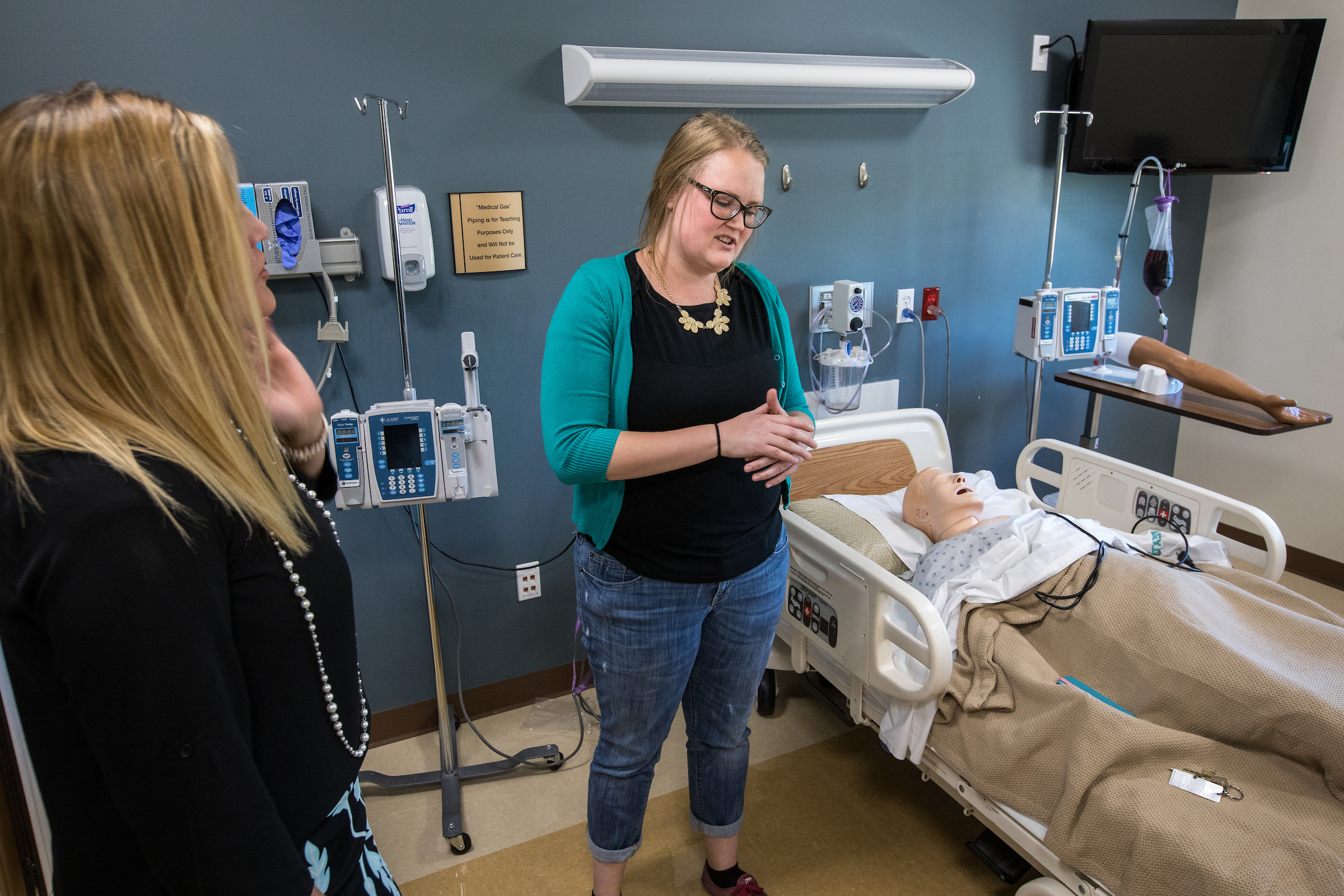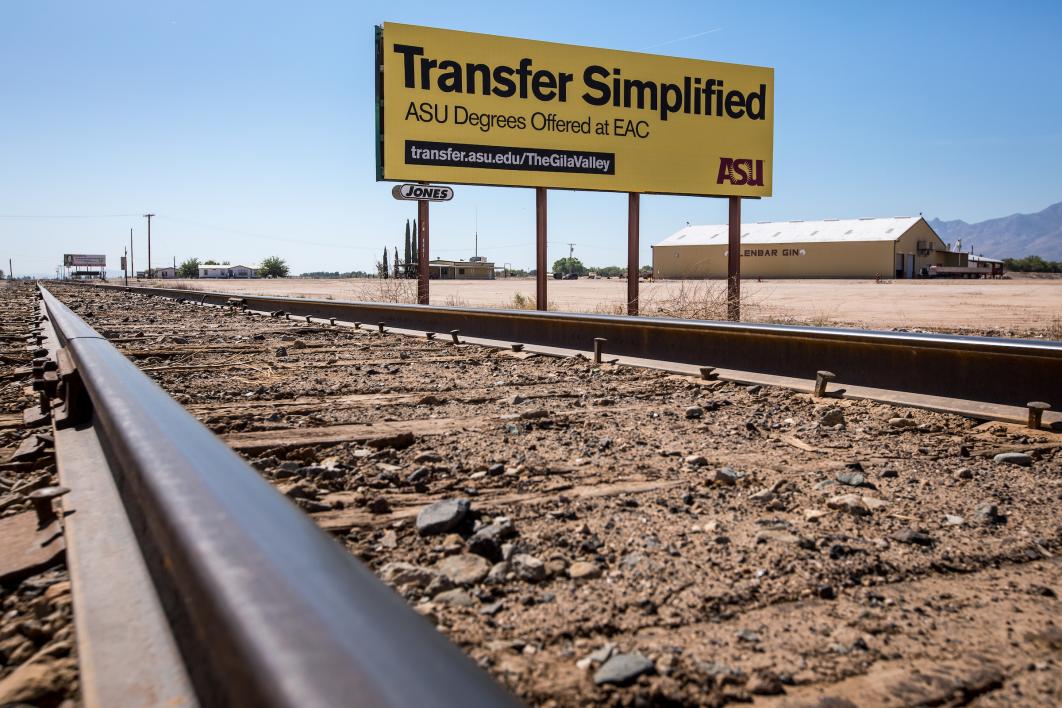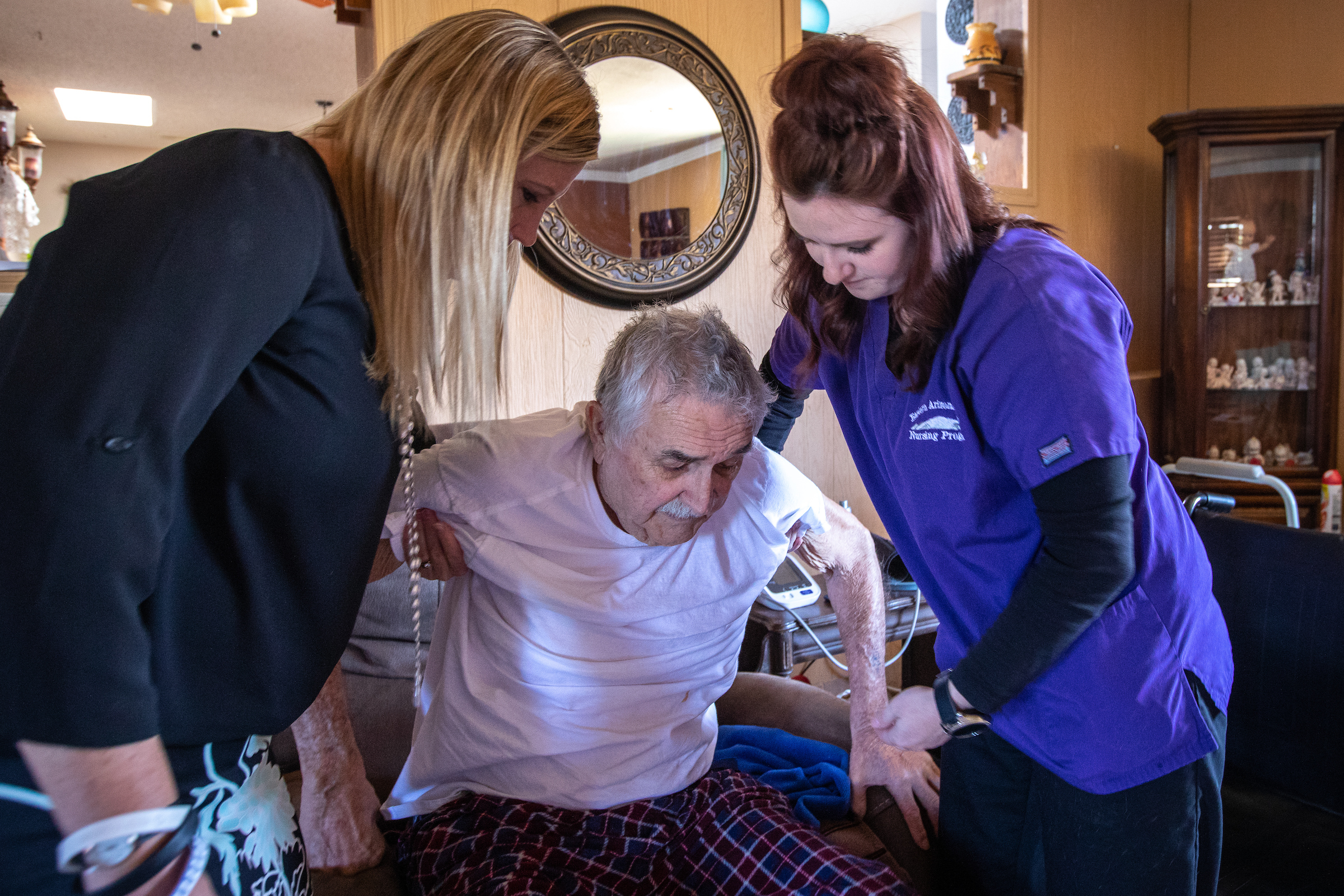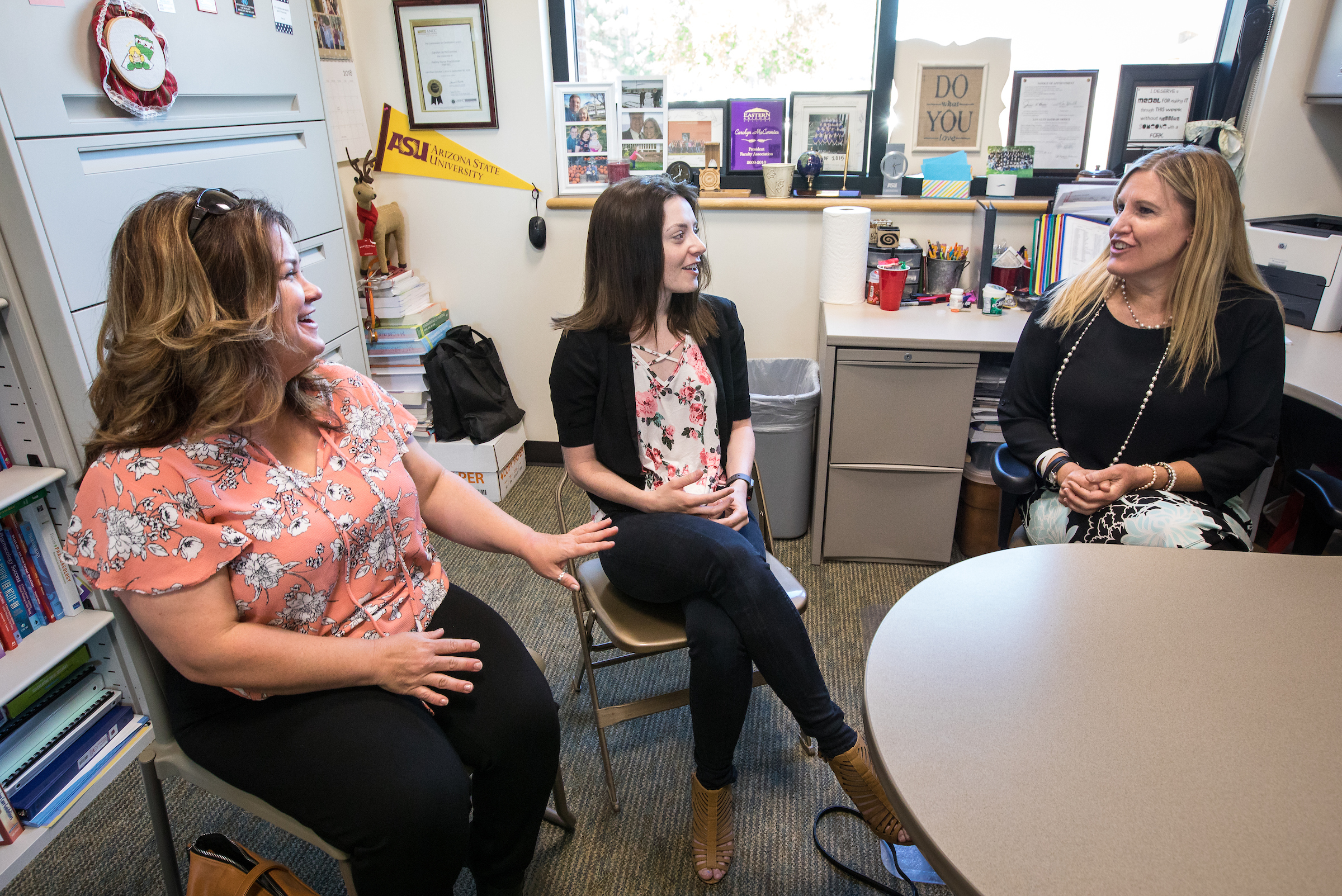A portrait of Florence Nightingale hangs on the wall in the nursing education building at Eastern Arizona College’s campus in Thatcher, Arizona, about 170 miles southeast of Phoenix. Program director Carolyn McCormies breezes past it on the way to her office on the first floor, pausing often to greet students with a cheerful hello.
“I make a point to know everybody’s name,” she said.
Exposed brick and natural wood beams greet visitors on their way to the second floor — thoughtful architectural details intended to evoke a sense of calm in the often-harried nursing students on their way to and from the high-tech clinical simulation lab where they interact with uncannily lifelike medical mannequins.
In the lab, McCormies adjusts a nozzle behind a “patient’s” hospital-grade gurney and a small, clear tube hisses to life as oxygen begins to flow.
“We wanted everything to be true to life for our students,” she said. “Everything works, and it’s very much like what you would see in a hospital.”
Second-semester nursing student Julia Bryce (right, in the clinical simulation room) talks about her experiences and goals in the RN-to-BSN program partnership between Eastern Arizona College and ASU. Photo by Charlie Leight/ASU Now
It’s clear from the get-go that the Eastern Arizona College (EAC) nursing program places a premium on its students’ needs, but it has only been six years since they’ve been able to offer them a bachelor’s degree. Before that, when McCormies was a student at EAC, the highest degree available was an associate. So once she completed the program, she headed to Phoenix for her bachelor’s degree and found a job at Chandler Regional Medical Center, where she stayed for 20 years.
Today, thanks to a partnership between EAC and Arizona State University, the EAC-ASU Baccalaureate Nursing Program gives rural nursing students the opportunity to earn a bachelor’s degree without ever leaving the campus in Thatcher, ensuring skilled health-care professionals and quality care aren’t lost to the bigger cities.
The concurrent-enrollment program — in which students take classes for both their associate and bachelor’s degrees at the same time — is quicker, cheaper and more flexible than other traditional nursing education tracks. Hybrid courses allow students already working in the field to get work done online, in their own time, and then ask whatever questions they have for their professors in person.
“Research shows that patient outcomes are better when nurses have a higher level of education, but many nurses with associate degrees find it very difficult to go back to school once they start working or have families,” McCormies said. “Our graduates have the opportunity to earn a bachelor’s degree along with their associate. The whole community benefits from having a program like this in their midst.”
A billboard a few miles from Eastern Arizona College's campus in Thatcher. Photo by Charlie Leight/ASU Now
On May 8, 16 graduates of the EAC-ASU program walked across the stage at the Phoenix Convention Center during ASU’s College of Nursing and Health Innovation convocation ceremony to receive their degrees and nursing pins. McCormies, who moved back to Thatcher in 2005 to raise her family, had the honor of pinning her daughter Kelly that day. Her older daughter, Heather, also graduated from the program a few years ago.
McCormies is thankful they were able to get their bachelor’s degrees without leaving their hometown.
“ASU has been a great thing for our family,” she said.
With 98 applicants for the fall 2018 semester, the EAC-ASU program is growing rapidly but it’s still small compared with other nursing programs — something the students love. Third-semester nursing student Cloe Wilford felt overlooked at one of the larger state universities, so she transferred to EAC.
“I was in these huge classes of 300 people, and nobody knew my name. I didn’t know anybody’s name. And you had to go through a TAteacher's assistant to get to the professor,” she said. “Here, the instructors give you their cell number on the first day and everybody knows your name. So it’s very personalized, and I can also get my bachelor’s. I wasn’t willing to go anywhere I couldn’t get my bachelor’s.”
Wilford and another student, Katie Miller, are heading to Honduras this summer as part of the program’s focus on service. The annual weeklong trip has become a sort of tradition over the past couple years, but McCormies, who went along last year, assures it’s no picnic.
Students sleep on the floor with mosquito nets and spend the day handing out medication and vitamins at a local clinic. And it’s up to them to raise enough funds to pay for their trip.
“It’s quite a sacrifice for the students,” McCormies said. “It’s not a free ride for any of them. But our thoughts about service is that it’s not just that we would like them to do it, it’s an expectation.”
Every student in the program is required to complete 10 hours of community service every semester, as well as four hours of “leadership time,” mentoring underclassmen. Many of the students get their community service hours by volunteering for a local hospice center.
Third-semester nursing student Katie Miller (far right) helps neighbor and hospice patient Tim Guttierrez into his wheelchair. Photo by Charlie Leight/ASU Now.
Miller was fortunate enough to be assigned to care for her longtime neighbor, Tim Guttierrez, a former mechanic and miner who now has dementia. Growing up, she would spend time playing cards with Guttierrez’s family at their kitchen table and feed their horses when they were away. Today, she sits with him in the back room he added to the house he has lived in since 1971 and keeps him company while he watches his Westerns. Sometimes she helps him into his wheelchair and they take a walk around the property.
“I’m not a big city person, so it’s perfect that ASU came to me,” Miller said. “And there’s the money. School is so expensive, so making it possible for us to do both programs and not have to pay it off for the rest of our lives is the best. I’ll have a lot less debt when I’m done than most people.”
During breaks from school, she works on the ortho-neuro floor at Carondelet St. Mary’s Hospital in Tucson, where she has seen firsthand the effects of burnout on some of the older nurses. She hopes that by getting her bachelor’s degree and then her master’s degree, she’ll be able to switch over to teaching once she gets to that point.
Many of the faculty at EAC who teach courses in the concurrent-enrollment program are themselves current or former nurses and nurse practitioners who were drawn to the classroom.
“The opportunity to be able to teach for ASU locally was really appealing,” said Sara Lemley, who teaches upper-division courses. She and fellow program faculty associate Shelley Vaughn relish the opportunity to bestow their students with a more well-rounded health-care education that includes such topics as global health and a research capstone course that requires them to consider the science and rationale behind medical practices.
“We challenge the students to work very hard,” Lemley said. “We have high standards for them. Seeing [program graduates] walk across the stage at ASU convocation just melts my heart because I know they all deserve to be there.”
(From left) EAC-ASU affiliate faculty Sara Lemley, program graduate Audree Adams-Dupont and program director Carolyn McCormies in her office. Photo by Charlie Leight/ASU Now
Though one of the aims of the program is to keep graduates in rural areas, some do move away. Audree Adams-Dupont, who graduated last May, is moving to Tucson after working at Mount Graham Regional Medical Center in Safford for the past year. But, she says, she plans to “keep her foot in the door” and will continue to work at the medical center, commuting from Tucson as needed.
“Right now, I have family in Tucson and I don’t have kids, so I want to experience the bigger city life,” she said. “But this is a great community. It’s really small, it’s really safe, everyone knows each other. This is definitely a place that, if I have a family, I would definitely consider coming back to.”
McCormies is proof positive that that happens.
“I’ve been back 13 years, and since I’ve been here, we’ve had nurses go on to become pharmacists, physicians, CRNAs [certified registered nurse anesthetists], nurse practitioners,” she said. “They’re going out and getting experience in their areas of specialty, and many of them are bringing that back here. And all that’s going to do is elevate our level of care in this area.”
Top photo: (From left) Recent program graduate Sammi Jensen, program director Carolyn McCormies and third-semester nursing student Cloe Wilford. Photo by Charlie Leight/ASU Now
More Health and medicine
College of Health Solutions program doing its part during Salute to Service
It wasn’t always easy for Marine veteran Chuck Hale when he first returned to civilian life. But he’ll never forget the help he received from a fellow former service member.“The first vet that helped…

What makes human culture unique?
Why is human culture — the shared body of knowledge passed down across generations — so much more powerful than animal cultures?“What’s special about our species?” is a question scientists have…
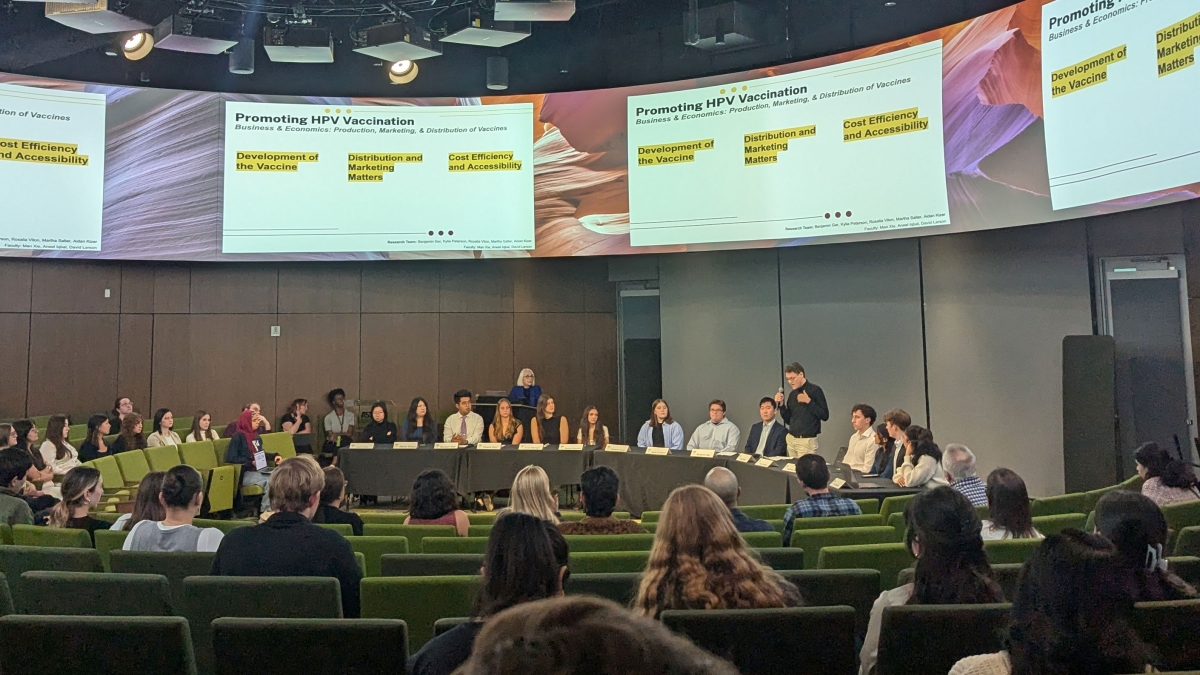
ASU honors students work on HPV research as part of Barrett College's largest-ever group thesis
Not every undergraduate student comes across the opportunity to do research as part of a team. Even fewer have had the chance to join a team of 86 students doing multidisciplinary research with real-…
